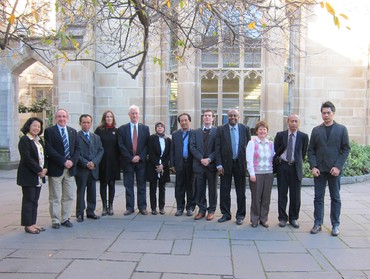A comparative study tour facilitated by AusHeritage on benchmarking of conservation management and methodologies in Australia, was undertaken by Indonesian conservation experts and Ministry of Culture and Tourism representatives, from June 26 to July 3, 2011. The group attended lectures and presentations, took part in various dialogues with AusHeritage members and conservation specialists and visited sites in Melbourne, Adelaide and Sydney.

AusHeritage board members Marcelle Scott, Peter Money, Catharine Millikan (Company Secretary), Andrew Durham (Treasureer), Roger Beeston (Deputy Chair) and Vinod Daniel (Chair) with some members of the Indonesian Visiting delegation. The visit was coordinated by Ian Cook (Deputy Chair, AusHeritage)
The delegates included Mr. Candrian Atthiyyat, the Director for Conservation Laboratory, Tourism and Culture Office, Mr. Made Kama Yoga, Head for the Regional Planning Division and Mr. Tri Praptiani, Head for the Laboratory Section, Conservation Laboratory, Tourism and Culture Office, Jakarta City Government; The General Director, Mr. Sahat Silaban, and staff from PT Tobas Tegar Indo; and Mr. Hubertus Sadirin, Conservationist and Trainer, Ministry of Culture and Tourism.
Indonesian presentations included ‘Profile of the Conservation Institute’ by Mr. Candrian Attachiyyat; ‘Conservation of Artifact’ conducted by the Conservation Institute and presented by Ms. Ninik; ‘Profile of the Museum Sejarah Jakarta’ (Jakarta Historic Museum) by Ms. Enny Prihantini; and ‘Technical Problem Encountered and Its Conservation Strategy of the Museum Sejarah Collection and its Buildings’ by Mr. Hubertus Sadirin.

Mr. Hubertus Sadirin
Mr. Hubertus Sadirin, an internationally renowned senior conservationist and trainer from the Indonesian Ministry of Culture and Tourism, also presented a lecture on ‘Caring for Borobudur – conserving world heritage in Indonesia’. He has been involved in heritage practice for thirty-seven years and was a key player during the Restoration of Borobudur project.

Budhist temple Candi Borobudur. Image: courtesy Ken Taylor
The Buddhist temple, Candi Borobudur, located in the geographical centre on the Island of Java, Indonesia and dating from the eighth century BCE, is one of the world’s great heritage sites. Interest in its protection goes back many years and there are records from as early as 1814.

Budhist temple Candi Borobudur. Image: courtesy Ken Taylor
A particularly important period in the ongoing management of the site focused on a long and multifaceted project for restoration and ongoing conservation between 1973 and 1983. This program was coordinated by UNESCO and the Indonesian Ministry of Education and Culture. This particular intervention in the history of Candi Borobudur halted its complete loss and is considered by many to be the most successful endeavour of its kind ever undertaken. Borobudur’s inscription on the World Heritage List in 1991, eight years after the end of the restoration project, represented a key outcome for the future sustainability of the monument.
